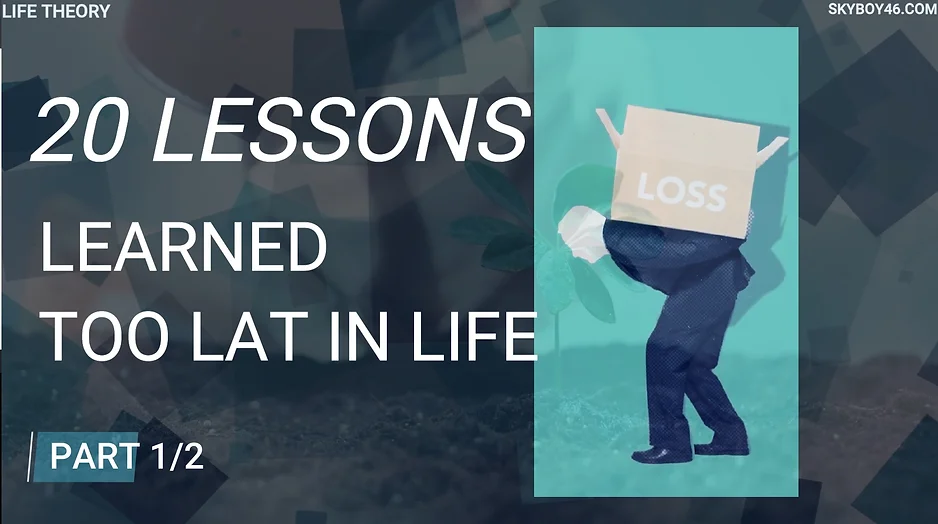Don’t Want To Read?
Watch/Listen To The Full Video on YouTube
Self-sabotage can be an exhausting and confusing cycle, especially when it feels like you’re always in your own way. At its core, self-sabotage often comes from unresolved past experiences—patterns of abandonment or insecurity that shape your beliefs and actions as an adult. If you’ve struggled with relationships, careers, or personal goals, it’s possible that old fears—like fear of abandonment or fear of engulfment—are driving your behavior. But the truth is, you can break free.
SUBSCRIBE: https://www.youtube.com/@LifeTheory46
Breaking Free from the Cycle of Self-Sabotage – Life Stories 152
Ready? Let’s explore why we end up stuck in these cycles and, more importantly, how we can break free.
What Self-Sabotage Really Looks Like
Have you ever found yourself in a pattern of broken relationships? Maybe you have a friend who seems to fall in and out of love every few months, or perhaps it’s you who can’t seem to make a commitment stick. Maybe you’re constantly changing jobs or starting new hobbies only to drop them before you even get the hang of things. It’s frustrating, confusing, and downright exhausting.
Often, self-sabotage is rooted in deep-seated beliefs that we’re not even consciously aware of. It’s like your brain is stuck in a loop, replaying old stories of not being good enough or worthy enough—stories that started long before you were even aware of them.
For many, these patterns begin early, often linked to experiences of feeling unsafe, insecure, or unloved during childhood. Abandonment trauma is common, and it doesn’t always stem from big, dramatic events. It can come from more subtle experiences like emotional neglect or being made to feel like you’re never quite measuring up.
As a child, these experiences shape your sense of self-worth. And as you grow, if those wounds go unresolved, they seep into your adult life. You may find yourself clinging to people who are unavailable or pushing away those who get too close. You may stay in toxic friendships or repeat the same mistakes in relationships because, deep down, part of you believes it’s what you deserve.
Self-Sabotage as a Self-Fulfilling Prophecy
You see, when you carry around beliefs like “I’m not good enough,” or “Everyone will leave me eventually,” your brain is always on the lookout for ways to confirm these beliefs. When something good starts happening—a new job, a promising relationship—part of you gets anxious. Your brain can’t reconcile the positive reality with your negative beliefs, so it tries to balance the equation. How? By sabotaging your progress.
When it comes to relationships, for example, things might start off great. But as soon as it becomes serious, old fears resurface. If you have a fear of abandonment, you may start to pick fights or pull away emotionally. If you have a fear of being engulfed or losing your sense of self, you may begin to shut down or sabotage the relationship by cheating or keeping your partner at a distance.
And the worst part? Once the relationship falls apart, you find yourself thinking, “See, I knew I wasn’t good enough. I knew they’d leave.” It’s a painful loop that feels impossible to escape.
How Your Past Shapes Your Present
At the heart of self-sabotage is usually a fear of intimacy. And no, intimacy doesn’t just mean physical closeness—it’s about allowing yourself to be fully seen, flaws and all. When you grow up with parents or caregivers who were dismissive, neglectful, or abusive, it can create deep-seated fears around intimacy. You may have learned that closeness equals pain, that vulnerability leads to rejection, or that it’s safer to keep people at a distance.
Psychologists call this attachment theory, which breaks down our relational patterns into four types:
- Secure – Comfortable with intimacy and independence.
- Anxious – Worries about being abandoned or unloved.
- Avoidant-Dismissive – Prefers emotional distance, sees intimacy as a loss of freedom.
- Avoidant-Fearful – Desires closeness but fears rejection, leading to a push-pull dynamic.
If you see yourself in any of the latter three categories, it might explain why you can’t seem to get out of your own way in relationships.
The Root Causes: Fear of Abandonment and Fear of Engulfment
Two fears often drive self-sabotaging behaviors:
- Fear of Abandonment – The anxiety that if you open yourself up, you’ll be left behind or replaced. This often leads to clingy, desperate behavior that ironically pushes people away.
- Fear of Engulfment – The fear that closeness will mean losing your independence or sense of self. People with this fear often push others away or resist commitment.
What’s worse is that these fears can coexist, creating a push-pull pattern that makes it almost impossible to sustain healthy, balanced relationships.
Breaking the Cycle
So, where do you go from here? Step one is radical honesty. Take a hard look at your behaviors and beliefs. Where did they come from? Who made you feel unworthy or unsafe? What experiences have you never really dealt with?
If you can, working with a therapist is ideal. But if that’s not an option, consider starting with some reflective journaling. Write down what you fear most in relationships or in your career. Then, look for the patterns. What happens every time you start to succeed or get close to someone?
Next, recognize that you can change. This is where commitment comes in. You have to commit to showing up, even when it’s uncomfortable, and facing those old fears head-on. Yes, it’s hard. But it’s worth it.
Commit to Growth, Not Perfection
Understand that healing isn’t a straight line. You’ll have good days and bad days. You’ll slip back into old patterns, and that’s okay. The goal isn’t to be perfect; it’s to be aware. Each time you catch yourself falling into self-sabotage, pause, breathe, and choose differently. Even if it’s just one tiny step, it’s progress.
And remember, your worth isn’t tied to your productivity, your success, or how well you can maintain a relationship. You’re worthy just as you are, and that’s the foundation you need to build from.
We’re All in This Together
Everyone has their struggles, but that doesn’t mean you have to face them alone. If this resonates with you, know that it’s okay to reach out for help. You’re not broken—you’re just a person who’s been hurt and is doing their best to heal.
So, let’s take this journey step-by-step. Focus on progress, not perfection, and we’ll see you back here tomorrow. Take care.
–> Read More Life Stories Here:
https://www.lifetheory.us
https://www.lifetheory.eu
Buy all of our Life Stories & Our Premium Learning Packs. Listen or Read to them anytime you want. Have them Forever.
You can get each monthly lesson on our website at https://www.skyboy46.com/store
SHARE THIS STORY
Visit Our Store
SHOP NOW
www.skyboy46.com & www.myskypet.com
Designed For Pet Lovers & Introverted Souls
Sport, Hobbies, Motivation, Music & Art






~EXPLORE MORE~
www.linktr.ee/skyboy46


